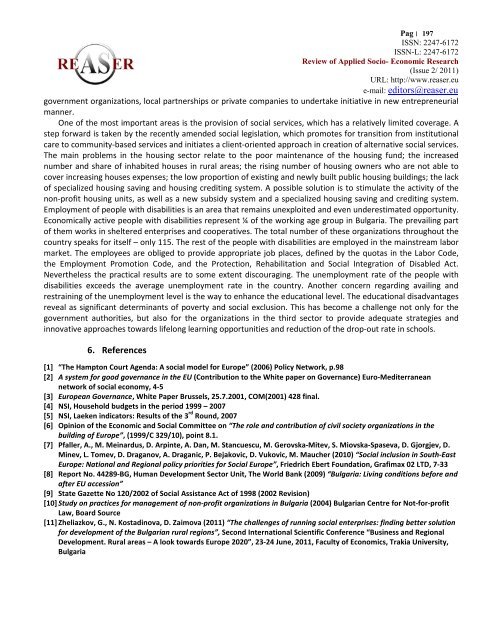Volume 2, ISSUE2/2011 - Review of Applied Socio-Economic ...
Volume 2, ISSUE2/2011 - Review of Applied Socio-Economic ...
Volume 2, ISSUE2/2011 - Review of Applied Socio-Economic ...
Create successful ePaper yourself
Turn your PDF publications into a flip-book with our unique Google optimized e-Paper software.
Pag׀ 197 ISSN: 2247-6172ISSN-L: 2247-6172<strong>Review</strong> <strong>of</strong> <strong>Applied</strong> <strong>Socio</strong>- <strong>Economic</strong> Research(Issue 2/ <strong>2011</strong>)URL: http://www.reaser.eue-mail: editors@reaser.eugovernment organizations, local partnerships or private companies to undertake initiative in new entrepreneurialmanner.One <strong>of</strong> the most important areas is the provision <strong>of</strong> social services, which has a relatively limited coverage. Astep forward is taken by the recently amended social legislation, which promotes for transition from institutionalcare to community-based services and initiates a client-oriented approach in creation <strong>of</strong> alternative social services.The main problems in the housing sector relate to the poor maintenance <strong>of</strong> the housing fund; the increasednumber and share <strong>of</strong> inhabited houses in rural areas; the rising number <strong>of</strong> housing owners who are not able tocover increasing houses expenses; the low proportion <strong>of</strong> existing and newly built public housing buildings; the lack<strong>of</strong> specialized housing saving and housing crediting system. A possible solution is to stimulate the activity <strong>of</strong> thenon-pr<strong>of</strong>it housing units, as well as a new subsidy system and a specialized housing saving and crediting system.Employment <strong>of</strong> people with disabilities is an area that remains unexploited and even underestimated opportunity.<strong>Economic</strong>ally active people with disabilities represent ¼ <strong>of</strong> the working age group in Bulgaria. The prevailing part<strong>of</strong> them works in sheltered enterprises and cooperatives. The total number <strong>of</strong> these organizations throughout thecountry speaks for itself – only 115. The rest <strong>of</strong> the people with disabilities are employed in the mainstream labormarket. The employees are obliged to provide appropriate job places, defined by the quotas in the Labor Code,the Employment Promotion Code, and the Protection, Rehabilitation and Social Integration <strong>of</strong> Disabled Act.Nevertheless the practical results are to some extent discouraging. The unemployment rate <strong>of</strong> the people withdisabilities exceeds the average unemployment rate in the country. Another concern regarding availing andrestraining <strong>of</strong> the unemployment level is the way to enhance the educational level. The educational disadvantagesreveal as significant determinants <strong>of</strong> poverty and social exclusion. This has become a challenge not only for thegovernment authorities, but also for the organizations in the third sector to provide adequate strategies andinnovative approaches towards lifelong learning opportunities and reduction <strong>of</strong> the drop-out rate in schools.6. References[1] “The Hampton Court Agenda: A social model for Europe” (2006) Policy Network, p.98[2] A system for good governance in the EU (Contribution to the White paper on Governance) Euro-Mediterraneannetwork <strong>of</strong> social economy, 4-5[3] European Governance, White Paper Brussels, 25.7.2001, COM(2001) 428 final.[4] NSI, Household budgets in the period 1999 – 2007[5] NSI, Laeken indicators: Results <strong>of</strong> the 3 rd Round, 2007[6] Opinion <strong>of</strong> the <strong>Economic</strong> and Social Committee on “The role and contribution <strong>of</strong> civil society organizations in thebuilding <strong>of</strong> Europe”, (1999/C 329/10), point 8.1.[7] Pfaller, A., M. Meinardus, D. Arpinte, A. Dan, M. Stancuescu, M. Gerovska-Mitev, S. Miovska-Spaseva, D. Gjorgjev, D.Minev, L. Tomev, D. Draganov, A. Draganic, P. Bejakovic, D. Vukovic, M. Maucher (2010) “Social inclusion in South-EastEurope: National and Regional policy priorities for Social Europe”, Friedrich Ebert Foundation, Grafimax 02 LTD, 7-33[8] Report No. 44289-BG, Human Development Sector Unit, The World Bank (2009) “Bulgaria: Living conditions before andafter EU accession”[9] State Gazette No 120/2002 <strong>of</strong> Social Assistance Act <strong>of</strong> 1998 (2002 Revision)[10] Study on practices for management <strong>of</strong> non-pr<strong>of</strong>it organizations in Bulgaria (2004) Bulgarian Centre for Not-for-pr<strong>of</strong>itLaw, Board Source[11] Zheliazkov, G., N. Kostadinova, D. Zaimova (<strong>2011</strong>) “The challenges <strong>of</strong> running social enterprises: finding better solutionfor development <strong>of</strong> the Bulgarian rural regions”, Second International Scientific Conference “Business and RegionalDevelopment. Rural areas – A look towards Europe 2020”, 23-24 June, <strong>2011</strong>, Faculty <strong>of</strong> <strong>Economic</strong>s, Trakia University,Bulgaria








